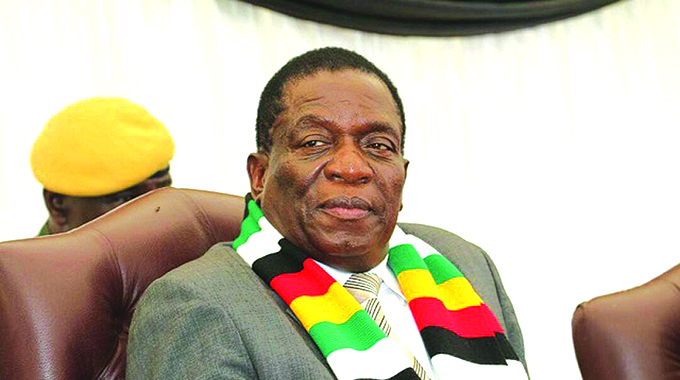President bemoans low uptake of infrastructure investments

Prosper Ndlovu in Victoria Falls
PRESIDENT Mnangagwa has bemoaned the low uptake of infrastructure investments by the private sector as a missing link in the country’s aggressive drive to rehabilitate and expand major infrastructure projects.
Despite the continued imposition of sanctions against Zimbabwe by the United States and its Western allies, which have crippled access to fresh lines of credit and global development support, the Second Republic led by President Mnangagwa is making significant strides in rolling out major infrastructure projects using limited domestic resources.
Guided by the National Development Strategy (NDS1), which builds the momentum towards Vision 2030, the Government continues to deploy budget funds to construct and upgrade several roads, dam and irrigation infrastructure, education and health development, as well as energy and Information Communication Technology (ICT) infrastructure roll out.
Among the flagship projects is the massive US$1.4 billion Hwange Power Station Unit 7 and 8 expansion, Lake Gwayi-Shangani construction, Lupane Provincial Hospital, US$300 million Beitbridge Border Post upgrade, Bulawayo-Harare Road dualisation and Chirundu-Harare-Masvingo-Beitbridge Highway, among other high impact capital investments across the country.
In his keynote address, read on his behalf by Matabeleland North Provincial Affairs and Devolution Minister Cde Richard Moyo, at the inaugural Infrastructure Summit and Expo here yesterday, President Mnangagwa said the Government infrastructure investment projects have started impacting positively on community livelihoods and are transforming the doing business environment.
As beneficiaries of infrastructure investments, he said the private sector must play an active role in transforming the economy through working closely with the Government.
The President said the Emergency Road Rehabilitation Programme (ERRP), for instance, has started benefiting previously marginalised communities such as Binga, Kanyemba, Tsholotsho and others in a big way, thereby ensuring that “no one and no place is left behind”.
All this is being done through “great sacrifice” and utilisation of scarce domestic resources to maintain and repair existing infrastructure, as well as completion of stalled projects.
“Whilst commendable progress has been made by the by the Government in infrastructure rehabilitation and expansion, we remain concerned with the low uptake of infrastructure investments by the private sector,” said President Mnangagwa.
“My Government is willing to enter into partnerships with the private sector in order to explore and exploit the vast investment opportunities in sectors such as railway, aviation, water and sanitation, power generation and irrigation development, among others.
“I, therefore, call upon the private sector to join Government in expanding and modernising our infrastructure.”
Private sector participation is provided for under crowd-in private capital models such as Build, Own and Operate (BOO), Build, Own and Transfer (BOT) and Repair, Own and Transfer (ROT).
Such Public Private Partnerships (PPPs), said the President, have proved successful elsewhere in the world and Zimbabwe should leverage more on its advantages.
He described the ongoing rehabilitation of the Harare-Masvingo-Beitbridge Highway as a prime testimony of his Government’s commitment to harness local resources and utilising local companies to develop state of the art infrastructure.
“This model is being extended to other sectors such as housing, ICT, education, health and border infrastructure, which are fundamental drivers for accelerating economic growth and development,” said President Mnangagwa. Already, my Government has put in place requisite institutional and regulatory framework through establishment of the Zimbabwe Investment Development Agency (ZIDA) in order to expedite the implementation of PPPs and promoting ease of doing business.”
Noting the significance of robust infrastructure development towards achievement of national and international development imperatives, the President said Zimbabwe was modelling its development strategy in line with regional and international bodies such as the SADC Industrialisation Strategy, Agenda 2063 of the African Unions as well as the UN 2030 Agenda for Sustainable Development.
As such, he said the New Dispensation was aware of the need to create a favourable macro-economic environment, which was being done through broad consultations with different stakeholders, implementation of several fiscal and monetary measures aimed at stabilising inflation, the exchange rate and improving the ease of doing business, which is critical for restoring investor confidence.
The President assured delegates that the Government will continue to deepen the engagement and re-engagement drive with the international community and financial institution to unlock long-term loans and other concessionary funding arrangements for infrastructure development.
In this regard, President Mnangagwa applauded China and Japan, in particular, for their continued support for Zimbabwe on infrastructure development and urged other countries to also come on board for mutually beneficial arrangements.
The National Economic Consultative Forum (NECF) hosted the high-level Infrastructure Summit under the theme: “Harnessing the Potential for Public-Private Partnerships (PPPs) to Resolve Infrastructure Challenges in Zimbabwe”.
In line with President Mnangagwa’s philosophy “Nyika inovakwa nevene vayo/ Ilizwe lakhiwa ngabaninilo” the conference buttressed the need for stakeholders to reflect and deliberate on sustainable financing options that will help Zimbabwe catch up and leap frog its regional compatriots in infrastructure development.
In their submissions, delegates who included senior Government officials, industrialists, academic and research consultants, representatives of regional and international development partners also concurred on the need to work together in developing major infrastructure as an enabler to transforming Zimbabwe into an upper middle-income economy by 2030. The conference also highlighted several investment opportunities in Zimbabwe and across the region with emphasis on mainstreaming integration in the broader development thrust for higher impact.











Comments